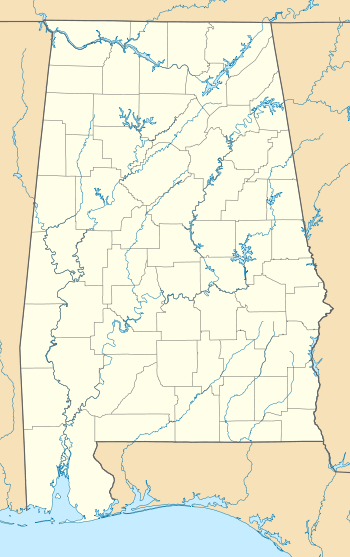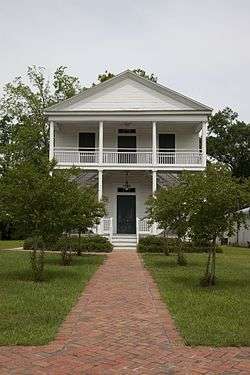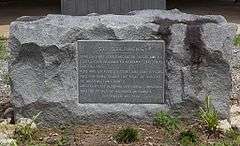St. Stephens, Alabama
| St. Stephens, Alabama | |
|---|---|
|
St. Stephens Courthouse in "New" St. Stephens, completed in 1854. | |
 St. Stephens, Alabama Location within the state of Alabama | |
| Coordinates: 31°32′25″N 88°3′19″W / 31.54028°N 88.05528°WCoordinates: 31°32′25″N 88°3′19″W / 31.54028°N 88.05528°W | |
| Country | United States |
| State | Alabama |
| County | Washington |
| Elevation | 226 ft (69 m) |
| Time zone | Central (CST) (UTC-6) |
| • Summer (DST) | CDT (UTC-5) |
| ZIP code | 36569 |
| Area code(s) | 251 |
| [1][2] | |
St. Stephens is an unincorporated census-designated place in Washington County, Alabama, United States. As of the 2010 census, its population was 495.[3] Located near the Tombigbee River in the southwestern part of the state and 67 miles north of Mobile, it is composed of two distinct sites: Old St. Stephens and New St. Stephens.[1][2] The Old St. Stephens site lies directly on the river and is no longer inhabited. It was the territorial capital of the Alabama Territory.[4][5] Now encompassed by the Old St. Stephens Historical Park, it is listed on the National Register of Historic Places.[6][7]
Changes in the territorial capital and transportation resulted in the Old St. Stephens site being bypassed by development. "New" St. Stephens developed two miles inland around a railway station, but adjacent to the old site. It is the location of the post office, Baptist and Methodist churches, and residences.[8] It has one building listed on the National Register and another on the Alabama Register of Landmarks and Heritage.[6][9]
Demographics
| Historical population | |||
|---|---|---|---|
| Census | Pop. | %± | |
| 1890 | 387 | — | |
| 2010 | 495 | — | |
| U.S. Decennial Census[10] | |||
St. Stephens first appeared on the 1890 U.S. Census as an unincorporated village. It did not reappear again until 2010 when it was classified as a census-designated place (CDP).
History
Old St. Stephens was situated on a limestone bluff that the Native Americans called Hobucakintopa, at the fall line along the Tombigbee River where rocky shoals forced the end of navigation for boats traveling north from Mobile, 67 miles to the south. As early as 1772, British surveyor Bernard Romans noted that "sloops and schooners may come up to this rapid; therefore, I judge some considerable settlement will take place."[5] By 1789, with the area back under Spanish control, the governor of Mobile, Juan Vincente Folch, established a fort and outpost here. By 1796 over 190 white inhabitants, mostly settlers from the United States, and their 97 or so slaves were living around the fort. With the Treaty of San Lorenzo, Spain turned the fort over to the United States government on February 5, 1799. It was included in the Mississippi Territory.[5][11]
The Choctaw Trading House was established in 1803 at St. Stephens. George Strother Gaines was appointed to head the Choctaw Agency in 1805. He continued to use the old Spanish blockhouse as the agency's store and established a land office in the former warehouse. The home of the former Spanish commandant served as Gaines' residence. In 1811 Gaines constructed what may have been the first brick building built by Americans in (today's) Alabama; it served as a warehouse.[5][11]
In 1804 Ephraim Kirby was appointed superior court judge of the Mississippi Territory by President Thomas Jefferson. In a letter to the president, Kirby described the inhabitants of St. Stephens as "illiterate, wild and savage, of depraved morals, unworthy of public confidence or private esteems, litigious, disunited, and knowing each other, universally distrustful of each other." Despite these factors, the trading post was active in the deerskin trade with the Choctaw. Pioneer minister Lorenzo Dow saw these weak points as a challenge, especially when he was asked to leave town. Dow, in a dramatic manner, prophesied the town's demise within a century, that it would become a "roosting place for bats and owls" and a ruin in which "no stone would lie upon another."[11][12]
Citizens living around Fort St. Stephens requested official recognition from the Mississippi Territorial legislature, which chartered the town of St. Stephens on January 8, 1807. The charter was amended on December 18, 1811, and the settlement was officially renamed Saint Stephens. By 1815, the Mississippi Territorial legislature surveyed the town site and lots were sold. Approximately 40 houses were reported in the town in 1816.[11]
Following Mississippi's statehood in 1817, the Alabama Territory was established. St. Stephens served as its territorial capital from 1817 to 1819, a period that saw the town grow at an astounding rate. By 1819 St. Stephens boasted over 500 homes. Its approximately 20 stores and commercial establishments included two hotels, legal and medical offices, and a theatre.[5][11]
|
Old St. Stephens Site | |
|
Marker placed by the Alabama Centennial Commission in 1922 | |
  | |
| Nearest city | St. Stephens, Alabama |
|---|---|
| Area | 74 acres (30 ha) |
| NRHP Reference # | [6] |
| Added to NRHP | December 29, 1970 |
Among the prominent citizens of St. Stephens was Henry Hitchcock, first attorney general of Alabama and later chief justice of the state Supreme Court. A post office was established in 1818, and George Fisher carried mail between St. Stephens and Mobile. Thomas Eastin published the Halcyon and Tombeckbe Advertiser, the fourth newspaper established in the Alabama Territory. Eastin described St. Stephens as a town of elegant tree-shaded homes, spacious streets, and genteel citizens. Washington Academy, a private boys school founded in 1811, was located on a prominent hill in town. The Tombecbe Bank, the first to be chartered in the state, was established by Israel Pickens, who would later become the third governor of Alabama.[5][11]
When the first state assembly adjourned at St. Stephens on February 14, 1818, many Alabama residents thought the capital should be moved to a more central location. Tuscaloosa was under consideration when Governor William Wyatt Bibb made the announcement in 1819 that the capital would be moved to Cahaba. This spelled certain doom for St. Stephens. In addition, the development of shallow draft boats permitted travelers to pass over the shoals and venture further upriver past the town. Lastly, yellow fever outbreaks decimated the citizenry.[5][11]
Within two decades, most of the remaining residents had moved less than two miles west of the river, to settle New St. Stephens; as it was served by a railway station. By 1833 the old town site was reduced in population to a small village; by the time of the American Civil War, it had largely been replaced by the new town.[5][11]
The old site was listed on the National Register of Historic Places on December 29, 1970.[6] The St. Stephens Historical Commission, which oversees the Old St. Stephens Historical Park, was incorporated in 1988, with a mission of promoting and sponsoring historical research and archaeological studies of Old St. Stephens. In 1999, the Alabama Historical Commission gave it a grant for archaeological studies. The goal was to complete a map of the old town site, denoting the location of streets, building foundations, cellar depressions, and cisterns, and to excavate some of the old building sites.[5]
"New" St. Stephens has one building listed on the National Register of Historic Places, the St. Stephens Courthouse. Listed on July 3, 1997, it has been restored by the St. Stephens Historical Commission to serve as a visitor center and local history museum near the entrance road to the Old St. Stephens Historical Park.[6][13] Additionally, the St. Stephens Methodist Church building, completed in 1857, was listed on the Alabama Register of Landmarks and Heritage on March 25, 1976.[9]
See also
References
- 1 2 U.S. Geological Survey Geographic Names Information System: St. Stephens, Alabama (New Saint Stephens)
- 1 2 U.S. Geological Survey Geographic Names Information System: Old Saint Stephens (historical)
- ↑ "American FactFinder". United States Census Bureau. Retrieved 2011-05-14.
- ↑ "Capitals of Alabama" Alabama Department of Archives & History (October 29, 2001). Retrieved May 4, 2005
- 1 2 3 4 5 6 7 8 9 "Old St. Stephens". Encyclopedia of Alabama. Auburn University. Retrieved June 21, 2011.
- 1 2 3 4 5 National Park Service (2009-03-13). "National Register Information System". National Register of Historic Places. National Park Service.
- ↑ "Visit the Park". Old St. Stephens Historical Commission. Retrieved June 21, 2011.
- ↑ ZIP Code Lookup
- 1 2 "The Alabama Register of Landmarks & Heritage". preserveala.org. Alabama Historical Commission. May 31, 2011. Archived from the original (PDF) on June 6, 2011. Retrieved June 6, 2011.
- ↑ "U.S. Decennial Census". Census.gov. Retrieved June 6, 2013.
- 1 2 3 4 5 6 7 8 "The History of Old St. Stephens". Old St. Stephens Historical Commission. Retrieved June 21, 2011.
- ↑ Nathan O. Hatch, The Democratization of American Christianity, (New Haven: Yale University Press, 1989), 37. For more on the prophecy account see: Richard J. Stockham, "The Misunderstood Lorenzo Dow," Alabama Review, 16 (1963):20.
- ↑ "Museum". Old St. Stephens Historical Commission. Retrieved June 21, 2011.
External links
| Wikimedia Commons has media related to St. Stephens, Alabama. |


